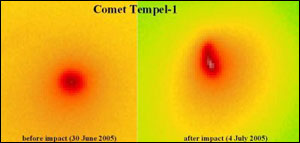Dust and gas from Comet 9P/Tempel 1 seen by ESA OGS

Dust from Comet 9P/Tempel 1 seen with the ESA OGS (red filter)
Dust and gas are seen in these images of Comet 9P/Tempel 1, as observed with the 1-metre ESA Optical Ground Station (OGS) telescope, located at the Observatorio del Teide on Tenerife, Canary Islands.
Two different filters have been used in different visible light observations to study different aspects of the comet’s nature. Red ’broadband’ filters allowed the detection of dust, while blue ’narrowband’ filters, filtering only carbon gaseous compounds, allow the observations to concentrate mainly on the gas emissions of the comet.
The first set of images (above) here were taken with a broadband red filter, four days before and about 15 hours after the impact respectively. The images were exposed for 10 minutes and show the dust coma of the comet. The dust brightness has increased by 50 percent.
A strong jet has recently appeared as a direct result of the impact, pointing north-north-east. The overall coma is very asymmetric in appearance. All structures must have been created by the outburst triggered by the impact.
The second set of images of Tempel 1 from the OGS telescope use a narrowband filter (C2 emission band). They show the coma gas mixed with smaller-sized dust particles than observed in the broadband red filtered image.
The observations were taken two days before and about 16 hours after the impact respectively. Also here the coma brightness has increased by 50 percent. Again the same strong jet is visible.
In the third set of images, Tempel 1 is seen about 16 hours after the impact. The two images show the refection of blue (BC filter) and red (RC filter) light from the dust cloud surrounding the comet nucleus.
These reflections show different dust particle sizes, with blue particles being smaller than red particles. It is clear that the jet structure of the smaller dust particles points towards the north (BC image), whereas the jet composed of larger dust particles (RC image) is rotated by about 45 degrees towards the north-east.
This means that the direction in which the dust particles were ejected from the comet nucleus after impact seems to depend on the particle size.
These images introduce ESA’s OGS telescope to the network of Earth-based observatories already taking part in the one of world’s largest astronomical observation campaigns – looking at results of the 4 July comet impact event.
Media Contact
More Information:
http://www.esa.int/SPECIALS/Rosetta/SEMQR06DIAE_0.htmlAll latest news from the category: Physics and Astronomy
This area deals with the fundamental laws and building blocks of nature and how they interact, the properties and the behavior of matter, and research into space and time and their structures.
innovations-report provides in-depth reports and articles on subjects such as astrophysics, laser technologies, nuclear, quantum, particle and solid-state physics, nanotechnologies, planetary research and findings (Mars, Venus) and developments related to the Hubble Telescope.
Newest articles

Silicon Carbide Innovation Alliance to drive industrial-scale semiconductor work
Known for its ability to withstand extreme environments and high voltages, silicon carbide (SiC) is a semiconducting material made up of silicon and carbon atoms arranged into crystals that is…

New SPECT/CT technique shows impressive biomarker identification
…offers increased access for prostate cancer patients. A novel SPECT/CT acquisition method can accurately detect radiopharmaceutical biodistribution in a convenient manner for prostate cancer patients, opening the door for more…

How 3D printers can give robots a soft touch
Soft skin coverings and touch sensors have emerged as a promising feature for robots that are both safer and more intuitive for human interaction, but they are expensive and difficult…





















